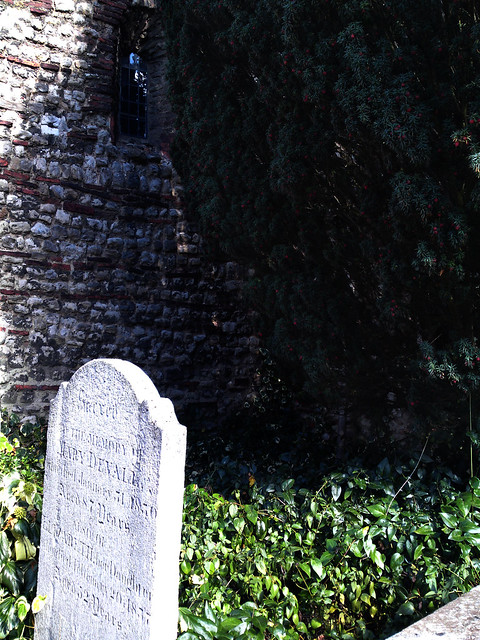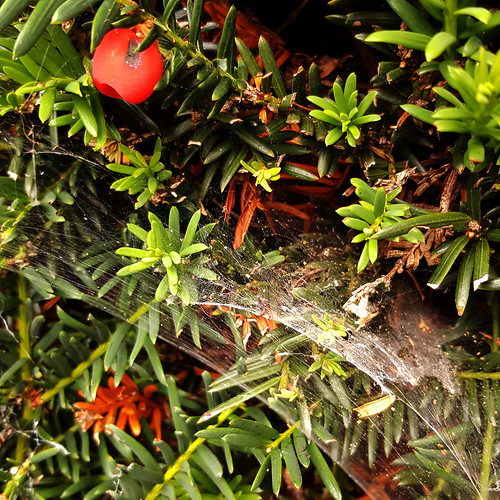Yew (Taxus baccata) is a very poisonous tree, appearing in both English legend and folklore. Source of the wood for our famous longbows, it also stands guard over churchyards and sacred sites.
The trees also grow to ancient ages, with some even believed to be as old as 2,500 years. True, it’s difficult to ‘date’ them when their ancient heartwood rots away. Yet dendocrinologists believe some British trees are definitely at least 2,000 years old.
But is its deathly reputation entirely deserved? Or has it earned its place in our national folklore?
Hit ‘play’ to hear the podcast episode, or keep reading to find out!
Historical Connections
The toxicity of the trees means they rarely appear in folk remedies or herbal medicine. That said, craftsmen used its wood to make longbows in medieval England. Its slow growth makes its wood tight-grained and tough. Its value to archers lies in its combination of heartwood and sapwood. The heartwood withstands compression and easily returns to its original shape. The sapwood withstands tension, and protects the heartwood from breakages.
According to Paul Kendall, the Fortingall yew in Glen Lyon, Scotland, is believed to be anywhere between 2,000 to 9,000 years old. In one legend, Pontius Pilate was either born under the tree or played in its branches as a child (2015).
While the Romans didn’t fully invade the UK until 43 AD, groups of Romans had visited the islands from 55 BC. Perhaps Pilate’s father simply heard the news of his son’s birth while visiting Fortingall. The legend may have distorted the facts, as they often do.

Its toxic reputation precedes it. Shakespeare mentions yew in Macbeth; the murderous king makes a deadly potion including “slips of yew, silvered in the moon’s eclipse”.
Yews and Origin Stories
There is a belief that the Celts brought the yew to Britain from Spain (Lee 1998: 570). Furthermore, M.R. Lee points out that Julius Caesar claimed the yew was sacred to the Druids (1998: 570). According to these Caesarian records, the Druid priest sat under the tree, where he dispensed his wisdom (1998: 570).
Yet the tree also became associated with immortality and even divinity. MR Lee recounts a tale in which a Yorkshire priest tried it on with a virgin, who refused his advances. He beheaded her, and hid her head in a yew tree. Yew trees often grow “fibrous hair-like growths” both on its roots and under the bark (1998: 570). Pilgrims to the yew tree took some of these growths as holy relics of the dead virgin’s hair. In the tale, so many pilgrims come to the tree that they rename the village. Houton becomes Halifax, or Holy Hair (1998: 570).
Sadly, this is unlikely. According to records, the name ‘Halyfax’ appears as the town’s name in 1091. This comes from an Old English name ‘halh-gefeaxe’, which means “area of coarse grass in the nook of land”.
The Yew and the Church
Yews are probably the most common trees found in old churchyards around Britain. Glennie Kindred observes that a lot of the churchyard yews were probably there before the churches were built, making them an earlier gathering place for small communities (1997). The Fortingall yew predates Christianity itself. Lee agrees with this theory, saying the Celts planted yews at their holy sites, which the Christians adopted as a custom (1998: 570).

Yet Mara Freeman notes another link between the tree and Christianity. The yews in Dyfed, Wales, allegedly bleed a red substance every year in sympathy with Christ, while branches of yew stood in for palm leaves on Palm Sunday. In some parishes, villagers would see in the New Year by gathering under the branches of the churchyard yew. Lee notes that in some parts of northern Europe, Christians sprinkled holy water during their services (1998: 570).
Amy Stewart explains that Roman invaders offered church services beneath yew trees to appeal to the pagan population. When the churches were built, they took over from the trees as a gathering point for the congregation (2010: 221).
Over on the Plant-lore.com website, you’ll find several theories as to why yews were planted in churchyards. They range from Christians appropriating sacred sites to the trees being planted in churchyards to keep grazing animals safe (2019).

Fred Gillam asserts that churchyard yews were actually planted to provide a wood source for longbows (2008: 44). However, Margaret Baker disagrees since one tree only provided enough wood for five bows, and many trees still survive in churchyards. Perhaps MR Lee is right when he asserts that farmers preferred yews in churchyards than on their land. At least that kept the toxic trees away from horses and cattle (1998: 571).
The Yew and Death
The Druids held the yew as a sacred tree, which symbolised death and resurrection in their culture. Its poisonous nature no doubt contributed to these connections. They’re often found to the south or south west of any nearby churches. A 1664 botany book by Robert Turner claimed that decaying corpses in the graveyard released poisonous gases. These vapours gathered under the branches of the yew tree, which then absorbed the gas. He claimed this was why the tree was so poisonous (Lee 1998: 571). The famous physician Galen even claimed lying under a yew could kill you.
It was often planted in graveyards because the roots were believed to grow through the eyes of the dead to hold them in place. I can’t find a definitive source for this belief, but it’s oft-repeated in various places.
By the 19th century, the trees had become a symbol of death. If someone brought yew into the house among the Christmas decorations, those in Suffolk believed it heralded a death in the family before the year ended. But in Derbyshire, people wove yew intentionally among the evergreen decorations, used specifically around the window.

When a fierce storm toppled an ancient tree in Selborne in 1990, locals found bones tangled among its roots (Stewart 2010: 221). Alfred, Lord Tennyson described the yew thus;
Thy fibres net the dreamless head
Thy roots are wrapt about the bones”
Tree of Resurrection
Yet the tree grows in an unusual fashion. Its branches grow downwards, and when they reach the ground they form new stems. These branches grow into separate but linked trunks (Barkham 2019). Unsurprisingly, this regenerative nature of the tree links it with resurrection, and the tree often symbolises the cycle of life.

The tree is sacred to Hecate, one of the guardians of the Underworld. In the fens, locals believed people should avoid the trees as they sheltered witches. Yet in Brittany, the tree held the corpses in place in churchyards by spreading a new root into each mouth.
At Ystradgynlais, Wales, groundsmen keep the yews pruned because of a local legend. It states the world will end when the smallest yew in the churchyard grows as high as the belfry (Baker, 2011, 163).
Other uses for the tree
Baker notes that yew is one of Ireland’s Five Magical Trees, and easily rivals oak, elder, rowan and hawthorn (2011: 162).
The yew doesn’t just herald doom and gloom. The trees protect houses, so it’s bad luck to cut one down. In Spain, people hung the branches from balconies to protect against lightning. They guarded against fire in the Hebrides when mingled with roof thatch (Baker 2011: 163).
Fascinated by how people used different things to protect their homes in earlier times? Sign up below and get my guide to five things that folklore says will do exactly that!
In other parts of the century, people gathered yew branches Easter and hung them in the kitchen to prevent heavy bread.

People used the branches in dowsing. Glennie Kindred also notes a peculiar belief in northern Scotland; apparently, if a person held a branch in their left hand, they could speak to anyone without that person being able to hear, although anyone else present could (1997).
A Life-Giving Tree?
While the tree is deeply poisonous, its extract actually bears antitumour properties. Medical trials use Taxol, derived from it, to fight ovarian, lung and breast cancers! (Stewart 2010: 223)
The trees are magical and ancient guardians in the British landscape. If you maintain healthy caution of their toxicity, they’re fascinating trees to investigate! I’m very fond of the huge specimens in Jesmond Old Cemetery. These silent guards always seem to have such character – so try greeting one next time you see one!
Enjoyed this post? Sign up and get your guide to protecting your home using items from folklore!
References
Baker, Margaret (2011), Discovering the Folklore of Plants, 3rd ed. Oxford: Shire Classics.
Barkham, Patrick (2019), ‘Britain’s ancient yews: mystical, magnificent – and unprotected’, The Guardian, https://www.theguardian.com/environment/2019/sep/28/britain-ancient-yews-mystical-magnificent-and-unprotected.
Freeman, Mara (no date) ‘Tree Lore: Yew’, Druidry, http://www.druidry.org/library/trees/tree-lore-yew.
Gillam, Fred (2008), Poisonous Plants in Great Britain, Glastonbury: Wooden Books.
Kendall, Paul (2015), ‘Yew’, Trees for Life, http://treesforlife.org.uk/forest/mythology-folklore/yew/.
Kindred, Glennie (1997), ‘The Yew: Sacred Tree of Transformation and Rebirth’, The White Dragon, http://www.whitedragon.org.uk/articles/yew.htm.
Lee, M.R. (1998), ‘The Yew Tree (Taxus Baccata) in Mythology and Medicine’, Journal of the Royal College of Physicians of Edinburgh, 28, pp. 569-575.
Plant-lore.com (2019), ‘Churchyard yews’, Plant-lore.com, https://www.plant-lore.com/plantofthemonth/churchyard-yews/.
Stewart, Amy (2010), Wicked Plants: The Weed That Killed Lincoln’s Mother & Other Botanical Atrocities, Portland, OR: Timber Press.
Watts, Victor, ed. (2010), “Halifax”, The Cambridge Dictionary of English Place-Names, Cambridge: Cambridge University Press.
Nutty about folklore and want more?
Add your email below and get these posts in your inbox every week.
You'll also get my 5-step guide to protecting your home using folklore!








I only knew about the tree’s use in bows. Fascinating stuff.
Thanks!
I did not know the yew tree had so much folklore associated with it I love the part about the roots and the eyes of dead people. Such a fascinating read.
Love your blog, Icy. Keep up the good work!
Thank you!
Only five bows per tree? Each bow would be, I’d guess, less than two metres long and a width that can be easily grasped in one hand. And we produced thousands of the things.
This doesn’t seem to add up. Do you have any more information to support it?
Not really. I just report on what I find.
We have just bought a plot of land and are building our new family home. I was going to cut down a couple of Yew trees to improve the view……I don’t think I am anymore.
Is there any way you can move them?
Hi there,
Moving them is not really an option but having delved into the symbolic history of the trees (I’m just reading John Connolly’s “A book of bones”) I think they should stay in place. I can look round them to get the view. It does seem every church or grave yard I see now has an old Yew in it. We live in Cookham in Berkshire and they have one that must be hundreds of years old…..it’s pretty in an odd way.
Yew trees always end up looking ‘bad tempered’ the older they get! They’re a fascinating tree though.